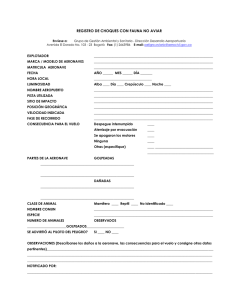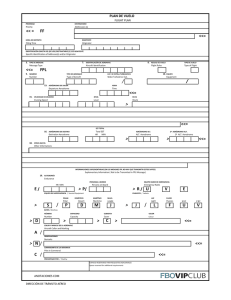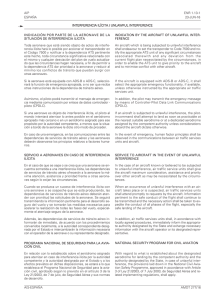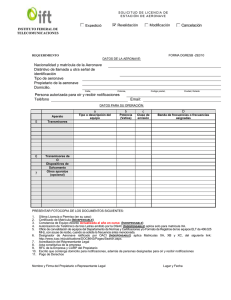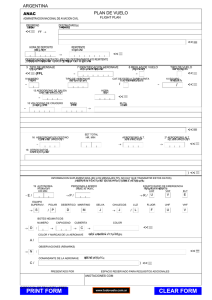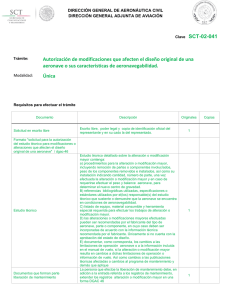ENR 1.12.fm
Anuncio
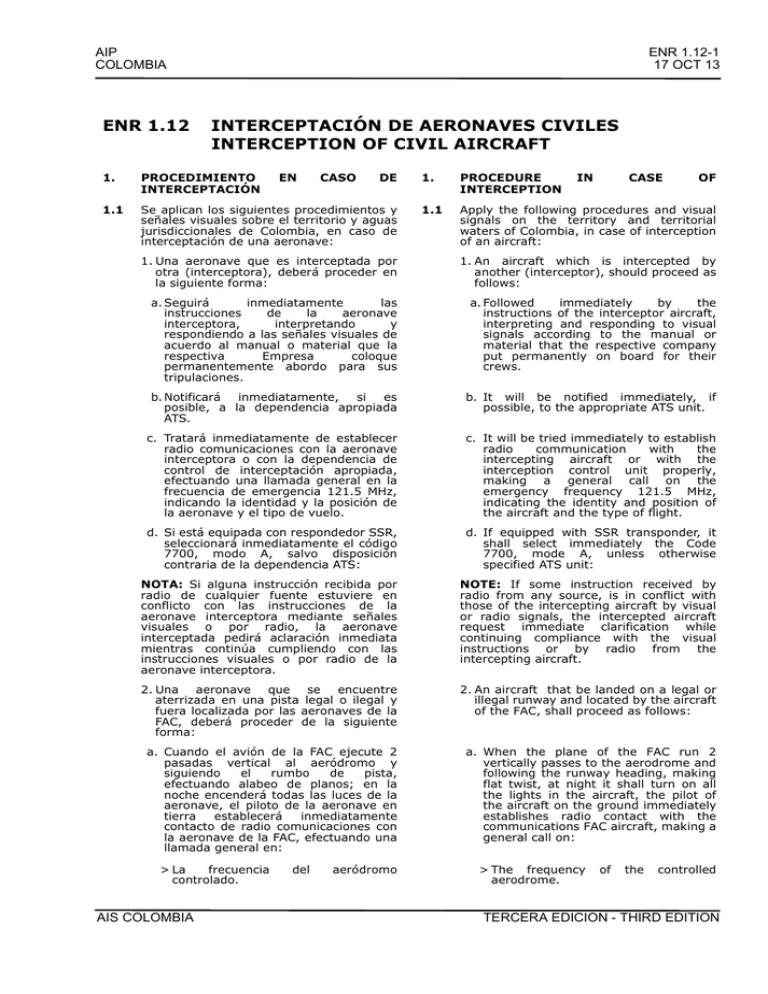
AIP COLOMBIA ENR 1.12 ENR 1.12-1 17 OCT 13 INTERCEPTACIÓN DE AERONAVES CIVILES INTERCEPTION OF CIVIL AIRCRAFT 1. PROCEDIMIENTO INTERCEPTACIÓN EN CASO DE 1.1 Se aplican los siguientes procedimientos y señales visuales sobre el territorio y aguas jurisdiccionales de Colombia, en caso de interceptación de una aeronave: 1. PROCEDURE INTERCEPTION IN CASE OF 1.1 Apply the following procedures and visual signals on the territory and territorial waters of Colombia, in case of interception of an aircraft: 1. Una aeronave que es interceptada por otra (interceptora), deberá proceder en la siguiente forma: 1. An aircraft which is intercepted by another (interceptor), should proceed as follows: a. Seguirá inmediatamente las instrucciones de la aeronave interceptora, interpretando y respondiendo a las señales visuales de acuerdo al manual o material que la respectiva Empresa coloque permanentemente abordo para sus tripulaciones. a. Followed immediately by the instructions of the interceptor aircraft, interpreting and responding to visual signals according to the manual or material that the respective company put permanently on board for their crews. b. Notificará inmediatamente, si es posible, a la dependencia apropiada ATS. b. It will be notified immediately, if possible, to the appropriate ATS unit. c. Tratará inmediatamente de establecer radio comunicaciones con la aeronave interceptora o con la dependencia de control de interceptación apropiada, efectuando una llamada general en la frecuencia de emergencia 121.5 MHz, indicando la identidad y la posición de la aeronave y el tipo de vuelo. c. It will be tried immediately to establish radio communication with the intercepting aircraft or with the interception control unit properly, making a general call on the emergency frequency 121.5 MHz, indicating the identity and position of the aircraft and the type of flight. d. Si está equipada con respondedor SSR, seleccionará inmediatamente el código 7700, modo A, salvo disposición contraria de la dependencia ATS: d. If equipped with SSR transponder, it shall select immediately the Code 7700, mode A, unless otherwise specified ATS unit: NOTA: Si alguna instrucción recibida por radio de cualquier fuente estuviere en conflicto con las instrucciones de la aeronave interceptora mediante señales visuales o por radio, la aeronave interceptada pedirá aclaración inmediata mientras continúa cumpliendo con las instrucciones visuales o por radio de la aeronave interceptora. NOTE: If some instruction received by radio from any source, is in conflict with those of the intercepting aircraft by visual or radio signals, the intercepted aircraft request immediate clarification while continuing compliance with the visual instructions or by radio from the intercepting aircraft. 2. Una aeronave que se encuentre aterrizada en una pista legal o ilegal y fuera localizada por las aeronaves de la FAC, deberá proceder de la siguiente forma: 2. An aircraft that be landed on a legal or illegal runway and located by the aircraft of the FAC, shall proceed as follows: a. Cuando el avión de la FAC ejecute 2 pasadas vertical al aeródromo y siguiendo el rumbo de pista, efectuando alabeo de planos; en la noche encenderá todas las luces de la aeronave, el piloto de la aeronave en tierra establecerá inmediatamente contacto de radio comunicaciones con la aeronave de la FAC, efectuando una llamada general en: a. When the plane of the FAC run 2 vertically passes to the aerodrome and following the runway heading, making flat twist, at night it shall turn on all the lights in the aircraft, the pilot of the aircraft on the ground immediately establishes radio contact with the communications FAC aircraft, making a general call on: > La frecuencia controlado. AIS COLOMBIA del aeródromo > The frequency aerodrome. of the controlled TERCERA EDICION - THIRD EDITION ENR 1.12-2 17 OCT 13 AIP COLOMBIA > La frecuencia de aeródromo controlado 122.9 MHz, ó no > The frequency of the uncontrolled aerodrome 122.9 MHz , or > La frecuencia de emergencia 121.5 MHz, indicando la identificación de la aeronave, nombre del piloto, último plan de vuelo efectuado, condición actual e intenciones. > The emergency frequency 121.5 MHz, indicating the aircraft identification, driver's name, the last flight plan done, current condition and purposes. b. Si la aeronave se encuentra con motor(es) encendido(s) procederá a apagarlos inmediatamente y a detenerse ya sea en la pista o en el área de parqueo, manteniéndose siempre visible. b. If the aircraft is powered on it shall proceed to turn it off immediately and stop at the runway or in the parking area, being always visible. c. Si el equipo de comunicaciones aeronáuticas de su aeronave estuviera fuera de servicio, la tripulación de la aeronave en tierra empleará el código de señales visuales tierra-aire contemplados en la AIP Colombia parte GEN 3.6-4. c. If the aeronautical communications equipment of its aircraft were out of the crew of the aircraft on the ground it shall use the code-to-air of visual signals referred in AIP Colombia GEN 3.6-4. d. La tripulación en tierra deberá seguir las instrucciones dadas por la aeronave interceptora esperando la llegada de la Fuerza Pública. d. The ground crew must follow the instructions given by the intercepting aircraft awaiting the arrival of the security forces. e. Si el personal de tripulantes de una aeronave en tierra incumple las instrucciones anteriores, su aeronave estará sujeta al empleo de las armas por parte de la FAC. e. If the staff of the crew of an aircraft on the ground violates the above instructions, your aircraft shall be subject to the use of weapons by the FAC. FRASES PARA USO DE AERONAVES INTERCEPTORAS/ PHRASES FOR USE BY INTERCEPTING AIRCRAFT Frase/ Phrase Pronunciación 1/ Pronunciation 1 Significado/ Meaning CALL SIGN KOL-SAIN ¿Cuál es su distintivo de llamada?/ What is your callsign? FOLLOW FOLOU Sígame/ Follow me DESCEND DISSEND Descienda para aterrizar/ Descend for landing YOU LAND YU LAND Aterrice en este aeródromo/ Land at this aerodrome PROCEED PROSIID Puede proseguir/ You may proceed FRASES PARA USO DE AERONAVES INTERCEPTADAS/ PHRASES FOR USE BY INTERCEPTED AIRCRAFT Frase/ Phrase Pronunciación 1/ Pronunciation 1 Significado/ Meaning Mi distintivo de llamada es de (Distintivo de llamada)/ My callsign is (Callsign) CALL SIGN (Distintivo de llamada)2/ (Callsign)2 KOL-SAIN (Distintivo llamada)2/ (Callsign)2 WILCO UIL -CO Cumpliré instrucciones/ Understood. Will comply CAN NOT CAN NOT Imposible cumplir/ Unable to comply TERCERA EDICION - THIRD EDITION AIS COLOMBIA AIP COLOMBIA ENR 1.12-3 17 OCT 13 Repita instrucciones/ Repeat your instrucion REPEAT RI PIT AM LOST AM LOST Posición desconocida/ Unknown position MAYDAY MEIDEI Me encuentro en peligro/ I am in distress HIJAK 3 JAI CHACK He sido objeto de apoderamiento ilícito/ I have been hijacked LAND (Lugar)/ (Place name) LAND (Lugar)/ (Place name) Permiso para aterrizar en (lugar)/ I request to land at (place name) (Place name) DESCEND DISSEND Permiso para descender/ I require descend 1. En la segunda columna se subrayan las sílabas que han de acentuarse. 1. In the second column highlights the syllables to be pronounced. 2. El distintivo de llamada que deberá darse, es el que se utiliza en las comunicaciones radiotelefónicas con los servicios de tránsito aéreo y corresponde a la identificación de la aeronave consignada en el plan de vuelo. 2. The callsign that should be given is the one used in radio communication with air traffic services and corresponds to the identification of the aircraft entered in the flight plan. 3. Según las circunstancias, no siempre será posible o conveniente utilizar el término ''HIJAK''. 3. Under the circumstances, will not always be possible or desirable to use the term''HIJAK.'' SEÑALES DE INTERCEPTACIÓN DE AERONAVES AIRCRAFT INTERCEPTION SIGNALS Cuando no sea posible la comunicación por radio, se debe utilizar el sistema de señales visuales indicadas a continuación. Los pilotos que intercepten, para poder transmitir sus instrucciones en forma visual, requieren aproximarse a la aeronave desde atrás y emplear el PATRÓN de identificación de aeronaves de transporte. Debe mantenerse una distancia de 500 ft por lo menos con la aeronave con que intercambia señales. Where it is not possible to communicate by radio, use the system of visual signals listed below. The pilots who intercept in order to convey their instructions in visual form, requires to approach from behind to the aircraft and use the aircraft identification pattern. It must keep a distance of 500 ft at least with the aircraft that exchanges signals. SEÑALES INDICADAS POR LA AERONAVE INTERCEPTORA Y RESPUESTA DE LA AERONAVE INTERCEPTADA INDICATED SIGNALS BY THE INTERCEPTING AIRCRAFT AND THE RESPONSE OF THE INTERCEPTED AIRCRAFT SERIES / SERIES 1. SEÑALES DE LA AERONAVE INTERCEPTORA/ SIGNALS OF THE INTERCEPTING AIRCRAFT DIA o NOCHE: Alabear la aeronave y encender y apagar las luces de navegación a intervalos irregulares (y luces de aterrizaje en el caso de un helicóptero) desde una posición ligeramente por encima y por delante y, normalmente a la izquierda de la aeronave interceptada (o a la derecha si la aeronave interceptada es un helicóptero) y, después de recibir respuesta, efectuar un viraje horizontal lento normalmente a la izquierda, (o a la derecha en el caso de un helicóptero) hacia el rumbo deseado. AIS COLOMBIA SIGNIFICADO / MEANING Usted ha sido interceptado, Sígame. RESPUESTA DE LA AERONAVE SIGNIFICADO INTERCEPTADA/ / RESPONSE OF THE MEANING INTERCEPTED AIRCRAFT DIA o NOCHE: Alabear la Comprendido aeronave, encender y apagar Lo cumpliré. las luces de navegación a intervalos irregulares y seguir a la aeronave interceptora. NOTA: En el Anexo 2, Capítulo 3.3.8, se prescriben las medidas complementarias que debe tomar la aeronave interceptada. TERCERA EDICION - THIRD EDITION ENR 1.12-4 17 OCT 13 AIP COLOMBIA NOTA 1: Las condiciones meteorológicas o del terreno pueden obligar a la aeronave interceptora a invertir las posiciones y el sentido del viraje citados anteriormente en la serie 1. NOTA 2: Si la aeronave interceptada no puede mantener la velocidad de la aeronave interceptora, se prevé que esta última efectúe una serie de circuitos de hipódromo y alabee la aeronave cada vez que pase a la aeronave interceptada. DAY or NIGHT: Prais the aircraft and flash the navigational lights at irregular intervals (and landing lights in the case of a helicopter) from a slightly position above and ahead, and usually to the left of the intercepted aircraft ( or right if the intercepted h aircraft is a helicopter) and, after receipt a response, make normally a slow level turn to the left (or right in the case of a helicopter) on the desired heading. You have been intercepted, follow me. DAY or NIGHT: Praise the Understood. shall aircraft, and flash the It navigational lights at comply. irregular intervals and follows the intercepting aircraft. NOTE: Annex 2, Chapter 3.3.8, prescribes measures to be taken by the intercepted aircraft. NOTE 1: The weather conditions or terrain that may require the intercepting aircraft to reverse the positions and direction of turn given above in Series 1. NOTE 2: If the intercepted aircraft cannot maintain the speed of the intercepting aircraft, the latter is expected to perform a series of racetrack and roll the aircraft each time it passes the intercepted aircraft. 2. 3. DIA o NOCHE: Alejarse Prosiga bruscamente de la aeronave interceptada, haciendo un viraje ascendente de 90° o más, sin cruzar la línea de vuelo de la aeronave interceptada. DIA o NOCHE: Alabear la Comprendido aeronave. . Lo cumpliré. DAY or NIGHT: Stay away sharply Proceed from the intercepted aircraft, making an ascending turn of 90 degrees or more without crossing the line of flight of the intercepted aircraft. DAY or NIGHT: Praise the Understood. aircraft. It shall perform. en DIA o NOCHE: Desplegar el tren de Aterrice aterrizaje (si es replegable) llevando este continuamente encendidos los aeródromo. faros de aterrizaje y sobrevolar la pista en servicio o, si la aeronave interceptada es un helicóptero, sobrevolar la zona de aterrizaje de helicóptero. DIA o NOCHE: Desplegar el Comprendido tren de aterrizaje (si es Lo cumpliré. replegable), llevando continuamente encendidos los faros de aterrizaje, seguir a la aeronave interceptora, si después de sobrevolar la pista en servicio a la zona de aterrizaje del helicóptero se considera que se puede aterrizar sin peligro, proceder al aterrizaje. En el caso de helicópteros, el helicóptero interceptado hace una aproximación para el aterrizaje, y permanece en vuelo estacionario cerca de la zona de aterrizaje. TERCERA EDICION - THIRD EDITION AIS COLOMBIA AIP COLOMBIA SERIES / SERIES ENR 1.12-5 17 OCT 13 SEÑALES DE LA AERONAVE INTERCEPTORA/ SIGNALS OF THE INTERCEPTING AIRCRAFT SIGNIFICADO / MEANING in DAY or NIGHT: Deploy the landing Landing gear (if fitted), showing steady the this landing lights turned on and fly over aerodrome. the runway in use or, if the intercepted aircraft is a helicopter, overflying the helicopter landing area. In the case of helicopters, the helicopter intercepted makes a landing approach, and remains hovering near the landing zone. 4. DIA o NOCHE: Replegar el tren de aterrizaje (de ser replegable) y encender y apagar los faros de aterrizaje sobrevolando la pista en servicio o la zona de aterrizaje de helicópteros a una altura de más de 300 m (1000 ft) pero sin exceder de 600 m (2000 ft) en el caso de un helicóptero, a una altura de más de 50 m (170 ft) pero sin exceder de 100 m (330 ft) sobre el nivel del aeródromo, y continuar volando en circuito sobre la pista en servicio o la zona de aterrizaje de helicópteros. Si no está en condiciones de encender y apagar los faros de aterrizaje, encienda y apague cualesquiera otras luces disponibles. El aeródromo que usted ha designado es inadecuado. DAY or NIGHT: Retract the landing gear (if fitted) and flash the landing lights overflying the runway in use or helicopter landing area at a height of over 300 m (1000 ft) but not exceeding 600 m (2000 ft) in the case of a helicopter at an altitude of more than 50 m (170 ft) but not exceeding 100 m (330 ft) above the aerodrome, and continue flying on the runway circuit service or helicopter landing area. The aerodrome you have designated is inadequate. DAY or NIGHT: Deploy the Understood. shall landing gear (if fitted), It showing steady the landing perform lights turned on, follows the intercepting aircraft, if after overflying the runway in the landing zone the helicopter can land safely proceed to landing DIA o NOCHE: Si se desea que la aeronave interceptada siga a la aeronave interceptora hasta un aeródromo de alternativa, la aeronave interceptora, repliega el tren de aterrizaje (de ser replegable) y utiliza las señales de la serie 1, prescritas para las aeronaves interceptoras. Comprendido Sígame. Comprendido prosiga. Si se decide dejar en libertad a la aeronave interceptada, la aeronave interceptora utilizará las señales de la serie 2, prescritas para las aeronaves interceptoras. If you are not able to flash the landing lights, flash any other lights available. DAY or NIGHT: If is wanted that the intercepted aircraft follows the intercepting aircraft to an alternative aerodrome, the intercepting aircraft, retract the landing gear (if fitted) and uses the Series 1 signals prescribed for intercepting aircraft. Understood, Follow me. Understood, proceed. If is decided to release the intercepted aircraft, the intercepting aircraft shall use the Series 2 signals prescribed for intercepting aircraft. DIA o NOCHE: Encender y apagar Imposible todas las luces disponibles a cumplir. intervalos regulares. DIA o NOCHE: Utilice las Comprendido señales de la serie 2, prescritas para las aeronaves interceptoras. DAY or NIGHT: Flash all the Impossible available lights at regular intervals. to achieve. DAY or NIGHT: Use the Understood Series 2 signals prescribed for intercepting aircraft. DIA o NOCHE: Encender y apagar En peligro. todas las luces disponibles a intervalos irregulares. DIA o NOCHE: Utilice las Comprendido señales de la serie 2, prescritas para las aeronaves interceptoras. DAY or NIGHT: available lights intervals. DAY or NIGHT: Use The Understood Series 2 signals prescribed for intercepting aircraft. 5. 6. RESPUESTA DE LA AERONAVE SIGNIFICADO INTERCEPTADA/ / RESPONSE OF THE MEANING INTERCEPTED AIRCRAFT AIS COLOMBIA Flash all the In risk. at irregular TERCERA EDICION - THIRD EDITION ENR 1.12-6 17 OCT 13 AIP COLOMBIA INTERCEPTACION DE AERONAVES/ AIRCRAFT INTERCEPTION DESCRIPCIÓN DE LOS MOTIVOS PARA QUE SE TOME LA DECISIÓN DE PERMISIÓN INMOVILIZACIÓN O NEUTRALIZACIÓN DE AERONAVES POR PARTE DE LA FAC DESCRIPTION OF THE REASONS FOR THE DECISION OF PERMISSION, DETENTION OR NEUTRALIZATION HAS TAKEN PERMISIÓN PERMISSION Autorización para que la aeronave interceptada continúe el itinerario de acuerdo a su plan de vuelo, una vez aclarada su situación; o una vez dirigida fuera de un área restringida o prohibida se autorice continuar su vuelo. Authorization to the intercepted aircraft continues the itinerary according to your flight plan, once cleared; or once led out of a restricted or prohibited area is allowed to continue its flight. RENDICIÓN PRESENTATION Evento en el cual la aeronave interceptada acata las órdenes, por lo tanto se suprimirá el empleo de las armas y se darán instrucciones a la aeronave interceptada de dirigirse a la Unidad Aérea más cercana o a un campo controlado por las Fuerzas de Superficie. Event in which the intercepted aircraft follow the orders, therefore shall be nonpermitted the use of weapons and the instructions be briefed to the intercepted aircraft heading to the nearest Air Force unit or to a controlled field by the surface forces. INMOVILIZACIÓN DETENTION Acción de impedir la movilización de una aeronave después de aterrizar, hasta el momento en que se haga presente una autoridad judicial competente con el fin de ponerla en conocimiento de los hechos y a órdenes de la misma. Action to prevent the movement of an aircraft after landing, until the moment that be made filed to a competent judicial authority in order to make known the facts and orders of it. INUTILIZACIÓN DEACTIVATION El objetivo de la acción en cuanto a la aplicación de la fuerza es primordialmente dejar inoperativa la aeronave. The objective of the action regarding the implementation of the force is primarily to leave the aircraft inoperable. NEUTRALIZACIÓN NEUTRALIZATION Acción de impedir que una aeronave catalogada como hostil cumpla la amenaza presentada con la violación del Estado Aéreo. La neutralización abarca desde la desviación, la inmovilización hasta la inutilización ya sea en vuelo o en tierra; dicha orden es emitida por el Comandante de la Fuerza Aérea una vez se haya cumplido el procedimiento. Action to prevent that an aircraft classified as hostile comply the threat posed to the violation of state air. The neutralization ranges from diversion to the disabling restraint either in flight or on land; the order is issued by the Commander of the Air Force once it has completed the procedure. TERCERA EDICION - THIRD EDITION AIS COLOMBIA AIP COLOMBIA ENR 1.12-7 17 OCT 13 AERONAVE HOSTIL (TH): HOSTIL AIRCRAFT (TH): El registro de la violación del espacio aéreo nacional por parte de una aeronave con fines presuntamente ilícitos o la indicación de una amenaza por parte de un aerodino contra los centros vitales de la Nación, la población, sus recursos y la Fuerza Pública. Esta situación obliga a la aplicación de la fuerza para minimizar o evitar el propósito del enemigo. The record of the violation of national airspace by an aircraft allegedly unlawful purposes or indicates a threat by an Aerodyne against the vital centers of the nation's population, resources and security forces. This requires the application of the force to minimize or avoid the enemy's purpose. De la misma forma, el desacatamiento de una aeronave hostil de las instrucciones de la FAC una vez agotadas las medidas disuasivas, obligarán a la utilización de las armas, previa autorización exclusiva del Comandante de la Fuerza Aérea Colombiana (FAC). Similarly, the contempt of a hostile aircraft of the FAC instructions after exhaustion of disincentives shall force the use of arms with the exclusive permission of the Commander of the Colombian Air Force (FAC). Se considerará hostil: 1. Una aeronave militar extranjera que ingrese al espacio aéreo de Colombia sin autorización. 1. Foreign military aircraft entering to the airspace of Colombia without permission. 2. Una aeronave que ingrese a un área prohibida, sin autorización. 2. An aircraft, which enters to a prohibited area without permission. 3. Una aeronave que esté volando a un nivel menor de 3.000 pies en un radio de 40 millas náuticas de una cabeza radar y/o de una Unidad Militar, sin identificar. 3. An aircraft that fly even lower level of 3,000 feet within 40 nautical miles from a radar head and / or a military unit, unidentified. 4. La aeronave que una vez interceptada no atiende las instrucciones del interceptor o registre una actitud evasiva, de agresión o ataque. 4. The aircraft that was intercepted once does not address the interceptor's instructions or register an evasive, action, aggression or attack. 5. Una aeronave que se encuentre aterrizada en un aeródromo ilegal sin autorización de la Unidad Administrativa Especial de la Aeronáutica Civil (UAEAC). 5. Aircraft that is illegally landed at an airfield without permission from the Unidad Administrativa Especial de la Aeronáutica Civil (UAEAC). 6. Una aeronave en operación nocturna desde pistas no autorizadas o sin plan de vuelo. 6. Aircraft in night operating from unauthorized runways or without a flight plan. 7. Una aeronave que una vez interceptada, arroje objetos o elementos fuera de ésta y que de forma sistemática desatienda las instrucciones de la aeronave de ataque o de combate de la FAC. 7. Aircraft that was intercepted once, throw objects or items out of this and that routinely disregard the instructions of the aircraft from attack or bout of FAC. 8. Una aeronave que sobrevuele sin autorización a una altura inferior a 3.000 pies de cualquier instalación militar. 8. Unauthorized aircraft flying at an altitude 3,000 feet lower than any military facility. No se aceptará la declaración por parte del piloto de la aeronave interceptada, en situación de emergencia por interferencia ilícita (secuestro) o por motivos técnicos, después de realizada una interceptación, con el fin de evitar el cumplimiento de las órdenes emitidas por el interceptor, cuando no haya sido reportada esta situación como tal a la autoridad ATS competente oportunamente y antes de iniciarse la interceptación. The statement shall not be accepted by the pilot of the intercepted aircraft in emergency situation by unlawful interference (hijacking) or for technical reasons, after making an interception, in order to avoid compliance with the orders issued by the interceptor, when this situation has been reported as such to the appropriate ATS authority and before the start of the interception. AIS COLOMBIA TERCERA EDICION - THIRD EDITION ENR 1.12-8 17 OCT 13 AIP COLOMBIA FASES PARA LA NEUTRALIZACIÓN DE AERONAVES 1. 2. 3. FASE “1” (Interceptación) PHASES FOR NEUTRALIZATION 1. AIRCRAFT PHASE "1" (Interception) La fase de interceptación (Fase I) incluirá los intentos por establecer contacto con la aeronave interceptada por radio y, de ser necesario, mediante señales visuales para determinar la identidad del piloto o de la aeronave interceptada. The interception phase (Phase I) include attempts to establish contact with the intercepted aircraft by radio and, if necessary, using visual signals to determine the identity of the pilot or aircraft intercepted. a. El interceptor se coloca ligeramente delante de la aeronave interceptada y efectúa llamados en las frecuencias de emergencia 121.5 MHz y 243.0 MHz y/o en las frecuencias VHF y UHF aeronáuticas del área. a. The interceptor is positioned slightly ahead of the intercepted aircraft and makes calls on the emergency frequency 121.5 MHz and 243.0 MHz and / or the frequencies VHF and UHF of an aeronautical area. b. Si no se logra comunicación por radio, el interceptor efectuará las señales visuales de interceptación de aeronaves (AIP Colombia ENR 1.12), asegurándose que el piloto de la aeronave interceptada vea las señales. b. If the radio communication is not possible, the interceptor shall do the visual signals of aircraft interception (AIP Colombia part ENR 1.12-), making sure that the pilot see the signals of the intercepted aircraft. c. El piloto de la aeronave interceptada debe cumplir las instrucciones del avión de la FAC; éste la guiará para que aterrice en el campo de aviación apropiado más próximo. Si el piloto de la aeronave interceptada no obedece las instrucciones, dicha aeronave será clasificada como hostil por la Fuerza Aérea Colombiana (FAC). c. The pilot of the intercepted aircraft should comply the instructions of the plane of the FAC he shall guide it to the landing at the nearest suitable airfield. If the pilot of the intercepted aircraft does not obey the instructions, the aircraft shall be classified as hostile by the Colombian Air Force. d. Permisión: Si se establece la legalidad de la aeronave sospechosa, el CCOFA puede otorgar autorización para que la aeronave identificada y/o interceptada continúe el itinerario de acuerdo con su plan de vuelo, una vez aclarada su situación, o una vez dirigida fuera de un área restringida o prohibida se autorice continuar su vuelo. En el caso que se encuentre en tierra, se concederá autorización para continuar en el sitio o con el despegue. d. Permission: If it’s set the legality of the suspicious aircraft, the CCOFA may grant permission for the identified and / or intercepted aircraft that continues the itinerary according to your flight plan, once clarified the situation, or when it has been directed out of a restricted or prohibited area is allowed to continue its flight. If you are on ground, It shall be granted permission to remain in the site of take off. FASE “2” (Disparos de advertencia) 2. PHASE 2 "(Warning Shots) De persistir el silencio de radio del piloto de la aeronave interceptada o caso omiso a las señales visuales, el piloto interceptor se coloca lateral de la aeronave interceptada con el fin que el piloto interceptado pueda observar las ráfagas de advertencia, mientras por frecuencia de emergencia se enuncia que en el momento “se están realizando disparos disuasivos y que si no se atienden las instrucciones la aeronave XXXX será inutilizada”. Of continued radio silence from the pilot of the intercepted aircraft, or the failure to visual signals, the interceptor pilot is placed aside to the intercepted aircraft with the purpose that the intercepted pilot can see the bursts of warning, while the frequency of emergency states that at the moment "are under fire deterrent and not heeds instructions XXXX shall be an unused aircraft." Si la aeronave interceptada atiende las llamadas o señales del avión interceptor se aplicará lo descrito en el literal “c.” de la FASE 1. If the intercepted aircraft handles calls or signs from the interceptor aircraft shall be applied as describes the paragraph "c" PHASE 1. FASE “3” (Inutilización) Si se registra una respuesta negativa de la aeronave hostil, se ejecutará la inutilización de la aeronave interceptada. TERCERA EDICION - THIRD EDITION 3. PHASE "3" (Deactivation) If is register a negative response from the hostile aircraft, it shall execute the disabling of the intercepted aircraft. AIS COLOMBIA AIP COLOMBIA ENR 1.12-9 17 OCT 13 ZONAS ESPECIALES AÉREO (ZECA) DE CONTROL SPECIAL ZONES OF AERIAL CONTROL (ZECA) Definición Definition Son sectores designados del Espacio Aéreo Colombiano delimitados por la Fuerza Aérea Colombiana, en coordinación con la Unidad Administrativa Especial de Aeronáutica Civil y que abarcan áreas en las cuales existe sospecha razonable de ser rutas utilizadas para el tráfico de drogas. They are designated sectors of Colombian air space defined by the Colombian Air Force, in coordination with the Unidad Administrativa Especial de Aeronáutica Civil and covering areas where there is reasonable suspicion of being routes used for drug traffic. Consideraciones Considerations En el espacio aéreo dentro de las ZECA, la Fuerza Aérea Colombiana aplicará el procedimiento establecido para “el empleo de aviones de la Fuerza Aérea Colombiana contra aeronaves que violen el espacio aéreo nacional“. En todas sus fases con el apoyo de los recursos suministrados por el Gobierno de los Estados Unidos de Norteamérica. The airspace within the Colombian air force ECAA applies the procedure for "the use of aircraft against the Colombian Air Force aircraft that violates national air space." In all its phases with the support of the provided resources by the Government of the United States. La Fuerza Aérea Colombiana no hará uso de la fuerza cuando las aeronaves clasificadas como hostiles se encuentren sobrevolando concentración de personas o edificaciones y que afecten a la población civil. Se hace la excepción cuando un centro urbano se declara zona prohibida por razones de seguridad o cuando se presente una amenaza de daño físico al personal, instalaciones del Gobierno de la República de Colombia o a otros. The Colombian Air Force shall not use force when aircraft are classified as hostile are overflying a concentration of buildings and affecting the civilian population. It is the exception when an urban center is declared off limits for security reasons or when were presented a threat of physical harm to personnel, facilities of the Government of the Republic of Colombia or others. Delimitación Delimitation A. Zona W A. W Zone Comprende el espacio aéreo colombiano al occidente de la cordillera occidental y el valle del Río Cauca, con excepción de la ciudad de Cali. (Ver carta anexa Nº 1.) It includes the Colombian airspace to the west of the western mountains range and the valley of the Cauca River, with the exception of the city of Cali. (See attached letter No. 1.) Todas las aeronaves deben: All the aircraft must: > Tramitar plan despegar. de vuelo antes de > Process a flight plan before takeoff. > Establecer comunicación con agencia ATS. > Communicate with ATS agency. > Mantener activado el equipo Transpondedor, con el código asignado por la Unidad Administrativa Especial de Aeronáutica Civil. > Keep the computer transponder activated, with the code assigned by the Unidad Administrativa Especial de Aeronáutica Civil. > Tener permiso para sobrevuelo en las áreas restringidas por la Fuerza Aérea Colombiana. > Have permission to overfly in restricted areas by the Colombian Air Force. > Para los aeródromos que se encuentren restringidos por la Fuerza Aérea Colombiana, sólo se autorizará que las aeronaves pernocten, previa autorización de la Fuerza Aérea Colombiana. > For airports that are constrained by the Colombian Air Force, only shall be allowed to tha aircraft stay overnight, with the authorization of the Colombian Air Force. AIS COLOMBIA TERCERA EDICION - THIRD EDITION ENR 1.12-10 17 OCT 13 AIP COLOMBIA B. Zona N B. N Zone Comprende el espacio aéreo colombiano al norte del país exceptuando las ciudades de Barranquilla y Cartagena. (Ver carta anexa Nº 2) It includes the Colombian airspace the north of the country except the cities of Barranquilla and Cartagena. (See attached letter No. 2) Todas las aeronaves deben: All the aircraft must: > Tramitar plan despegar. de vuelo antes de > Process a flight plan before takeoff. > Establecer comunicación con agencia ATS. > Communicate with ATS agency. > Mantener activado el equipo Transpondedor, con el código asignado por la Unidad Administrativa Especial de Aeronáutica Civil. > Keep the computer transponder activated, the code assigned by the Unidad Administrativa Especial de Aeronáutica Civil. > Tener permiso para sobrevuelo en las áreas restringidas por la Fuerza Aérea Colombiana. > Have permission to fly in restricted areas of the Colombian Air Force. > Para los aeródromos que se encuentren restringidos por la Fuerza Aérea Colombiana, sólo se autorizará que las aeronaves pernocten, previa autorización de la Fuerza Aérea Colombiana. > For airports that are constrained by the Colombian Air Force, only shall be allowed to the aircraft to stay overnight, with the authorization of the Colombian Air Force. TERCERA EDICION - THIRD EDITION AIS COLOMBIA AIP COLOMBIA ENR 1.12-11 17 OCT 13 C. Zona E C. E Zone Comprende el Espacio aéreo colombiano al Oriente y Sur del país. (Ver carta anexa Nº 3) It includes the colombian airspace to the East and South of the country. (See attached letter No. 3) Todas las aeronaves deben: All the aircraft must : > Tramitar plan de vuelo antes de despegar, en especial para pistas no controladas. > Process a flight plan before taking off, especially for non-controlled runways. > Establecer ATS. > Communicate with ATS agency. comunicación con agencia > Mantener activado el equipo Transpondedor, con el código asignado por la Unidad Administrativa Especial de Aeronáutica Civil. > Keep the computer transponder activated, with the code assigned by the Unidad Administrativa Especial de Aeronáutica Civil. > Tener permiso para sobrevuelo en las áreas restringidas por la Fuerza Aérea Colombiana. > Have permission to overfly in restricted areas of the Colombian Air Force. > Para los aeródromos que se encuentren restringidos por la Fuerza Aérea Colombiana, solo se autorizará que las aeronaves pernocten, previa autorización de la Fuerza Aérea Colombiana. > For airports that are constrained by the Colombian Air Force, only shall be allowed to the aircraft to stay overnight, with the authorization of the Colombian Air Force. > Las aeronaves que se encuentren volando a nivel inferior y en un radio de 150 millas náuticas de la Base Aérea de Marandúa (Vichada), deben establecer comunicación con la Torre de “Rodríguez Meneses”, en frecuencia 126.2 MHz. > The aircraft that are flying at lower levels and in a radius of 150 nautical miles from Marandúa Air Base (Vichada) must communicate with the "Rodriguez Meneses" tower in frequency 126.2 MHz AIS COLOMBIA TERCERA EDICION - THIRD EDITION ENR 1.12-12 17 OCT 13 AIP COLOMBIA Delimitación de las áreas (Latitud/Longitud)/ Delimitation of areas (Latitude / Longitude) 1. 07 13 11 N 077 53 12 W 2. 08 31 42 N 077 21 36 W 3. 08 40 28 N 077 21 32 W 4. 08 50 06 N 077 14 00 W 5. 12 06 04 N 070 55 02 W 6. 07 00 00 N 072 00 12 W 7. 06 09 22 N 072 11 48 W 8. 05 40 48 N 072 54 24 W 9. 04 36 05 N 073 56 53 W 10. 03 18 47 N 072 58 38 W 11. 03 18 47 N 073 56 53 W 12. 05 27 50 N 074 11 48 W 13. 06 10 48 N 074 03 54 W 14. 07 01 15 N 074 42 34 W 15. 07 01 15 N 075 33 52 W 16. 06 32 00 N 076 13 31 W 17. 05 08 28 N 076 13 31 W 18. 05 08 28 N 075 42 38 W 19. 08 08 28 N 075 11 15 W 20. 02 34 51 N 076 17 40 W 21. 02 34 51 N 074 56 40 W 22. 01 28 28 N 075 29 17 W 23. 00 25 16 N 076 14 50 W TERCERA EDICION - THIRD EDITION AIS COLOMBIA
